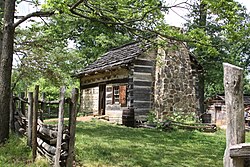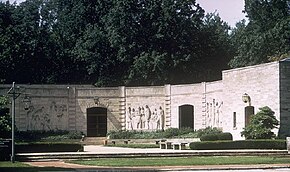Lincoln Boyhood National Memorial
Lincoln Boyhood National Memorial | |
U.S. National Memorial | |
 Lincoln Farm (replica) | |
| Location | IN 162, Lincoln City, Indiana, United States |
|---|---|
| Coordinates | 38°7′6″N 86°59′49″W / 38.11833°N 86.99694°W |
| Area | 200 acres (81 ha) |
| Built | 1816 |
| Architect | Bishop, Richard E.; Olmsted, Frederick Law |
| Website | Lincoln Boyhood National Memorial |
| NRHP reference No. | 66000012[1] |
| Significant dates | |
| Added to NRHP | October 15, 1966 |
| Designated NHLD | December 19, 1960 |
| Designated NMEM | February 19, 1962 |
Lincoln Boyhood National Memorial is a
Included in the park is the Lincoln Living Historical Farm. The Lincoln Boyhood Home was named a
Memorial features
Memorial building
The centerpiece of the memorial is a one-story limestone ashlar memorial building completed in 1945 that features five sculpted panels portraying different phases of Lincoln's life.[3] It has a small theater featuring a 16-minute film about Lincoln's life in Indiana. The museum features several exhibits and artifacts related to Lincoln's life, which are located in an adjoining hall. A private gallery displays Lincoln-related artwork, including numerous portraits and lithographs of Lincoln and his family. The park holds an oil portrait of Nancy Hanks Lincoln, done by an artist long after her death. A chapel and meeting hall can be rented for public weddings and other gatherings.
Historical farm
Nearby is the site of the original Lincoln cabin; the
History
Lincoln in Indiana

Abraham's father
The family took two weeks in 1816 to move to
Following his mother's death, young Abraham Lincoln continued to work on the farm and was cared for by his older sister
In November 1819, the area's first school was opened by Andrew Crawford, and at age 10, Abraham attended a school for the first time, at a cost of two dollars per year. He was a student there for two school years, which were three-month intervals held during the winter months when the children were not needed for farming. In 1822 the Lincolns enrolled the boy in a new school taught by James Swaney. As it was more than 4 miles (6.4 km) away and Abraham had to walk there, his attendance was poor. In 1824 he was transferred to another school closer to home, which he attended until age 16, when he ended formal schooling.[9] In January 1826, Abraham's only sister Sarah died during the birth of her first child, who was stillborn. She was buried in the Little Pigeon Creek Primitive Baptist Church cemetery.[7]
As he grew, Abraham began taking outside jobs, often working for twenty-five cents a day clearing land, plowing fields, and building fences. When he was not working, he spent a great deal of time at the James Gentry General Store and the two nearby
Making the memorial
The site attracted little attention as a link to Lincoln's past until 1879, during a period of increased activity in the North and the South of memorializing following the
In 1927 the Indiana Lincoln Union was formed to raise funds and encourage support for a memorial to recognize Lincoln's years in the Hoosier state. In 1932 the state established the adjacent Lincoln State Park to protect the area and preserve the historic homestead site. The state transferred part of that area to the memorial district, including the grave site of Nancy Lincoln (and what was found to be 29 other graves), now included in what is called Pioneer Cemetery. The Union continued to raise funds to make improvements to the site in the 1930s and 1940s, during the Great Depression and World War II. It completed construction of the Memorial building in 1944. It has five bas-relief panels portraying different periods of Lincoln's life, designed by sculptor Elmer Daniels.[11]
In the 1930s the Civilian Conservation Corps (CCC) helped mold much of the memorial's surrounding landscape, including an iconic grass alleyway leading from the memorial center to the pioneer cemetery. In 1934, a CCC crew located and excavated the original hearthstones of the Lincoln family farm. These workers also helped plant more than 22,000 native trees to restore that part of the county to something similar to the wilderness a young Abraham Lincoln would have seen when his family first came to Indiana. Today, high school students continue helping maintain and improve the national park through the Youth Conservation Corps.[12]
In 1962 the Indiana legislature approved donating another 114 acres (46 ha) to the district and the Lincoln Boyhood National Memorial was created. The U.S. Congress authorized the national memorial on February 19, 1962, placing it under the National Park Service. The memorial district was listed on the National Register of Historic Places, on October 15, 1966. In 1968 the NPS created the Living Historical Farm after "meticulous research" about the period, to help visitors better understand the lives of Lincoln, his family and neighbors during the frontier years in the area.[11]
Gallery
-
Memorial entrance
-
Memorial courtyard
-
The foundation of the Lincolns' cabin
-
Lincoln in Kentucky
-
Lincoln in Indiana
-
Lincoln in Illinois
-
Lincoln inWashington D.C.
-
Lincoln's legacy
-
Cabin at the Living Historical Farm
-
"There I Grew Up...," A History of Abraham Lincoln's Boyhood Home
See also
- Lincoln's Tomb
- Lincoln Memorial
- List of national memorials of the United States
- Open-air museum
- Presidential memorials in the United States
References
- ^ "National Register Information System". National Register of Historic Places. National Park Service. March 13, 2009.
- ^ Shedd, Charles E. (June 16, 1959). "National Historic Landmark Nomination: Nancy Hanks Lincoln State Memorial". National Park Service. and Accompanying photos
- ^ Arbogast pp. 7.1, 8.2
- ^ Arbogast p. 8.2
- ^ Funk, p. 40
- ^ Funk, p. 41
- ^ a b c Funk, p. 43
- ^ Funk, p. 44
- ^ a b c Funk, p. 42
- ^ Eric Foner, Race and Reunion
- ^ a b Arbogast p. 8.1
- ^ "A labor of history: Youth Conservation Workers spend summer tend to Lincoln's boyhood home". Spencer County Journal Democrat. July 17, 2019. Retrieved July 18, 2019.
Sources
- Arbogast, David (March 1976). Lincoln Boyhood National Memorial NRHP Nomination Form. National Park Service.
- The National Parks: Index 2001–2003. Washington: U.S. Department of the Interior.
- Funk, Arville L (1983) [1969]. A Sketchbook of Indiana History. Rochester, Indiana: Christian Book Press.
- O'Bright, Jill York. "There I Grew Up...," a History of the Administration of Abraham Lincoln's Boyhood Home. Retrieved June 28, 2012.
External links
 Lincoln Boyhood National Memorial travel guide from Wikivoyage
Lincoln Boyhood National Memorial travel guide from Wikivoyage- "Lincoln Boyhood National Memorial". National Park Service. Retrieved February 9, 2009.
- "Lincoln Boyhood National Memorial: Forging Greatness during Lincoln's Youth". National Park Service Teaching with Historic Places. Retrieved February 9, 2009.
- Lincoln Amphitheatre












